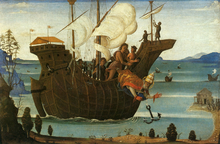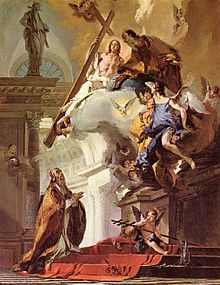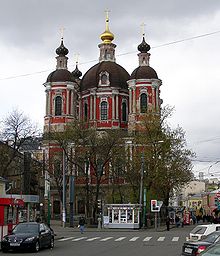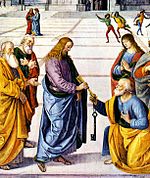- Pope Clement I
-
Saint Clement I 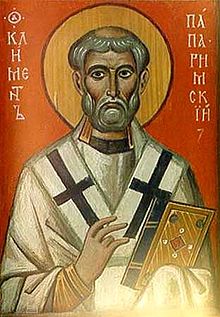
Papacy began 92 AD Papacy ended 99 AD Predecessor Anacletus Successor Evaristus Personal details Born 1st century AD
Rome, Roman EmpireDied traditionally 99 or 101
Chersonesus,
Taurica, Bosporan Kingdom
(modern-day Crimea, Ukraine)Other Popes named Clement Pope Clement I (fl. 96),[1] also known as Saint Clement of Rome (in Latin, Clemens Romanus), is listed from an early date as a Bishop of Rome.[1] He was the first Apostolic Father of the Church.[2]
Few details are known about Clement's life. According to Tertullian, Clement was consecrated by Saint Peter,[2] and he is known to have been a leading member of the church in Rome in the late 1st century. Early church lists place him as the second or third[1][3] bishop of Rome after Saint Peter. The Liber Pontificalis[4] presents a list that makes Linus the second in the line of bishops of Rome, with Peter as first; but at the same time it states that Peter ordained two bishops, Linus and Cletus, for the priestly service of the community, devoting himself instead to prayer and preaching, and that it was to Clement that he entrusted the Church as a whole, appointing him as his successor. Tertullian too makes Clement the immediate successor of Peter.[5] And while, in one of his works, Jerome gives Clement as "the fourth bishop of Rome after Peter" (not in the sense of fourth successor of Peter, but fourth in a series that included Peter), he adds that "most of the Latins think that Clement was second after the apostle".[6] Clement is put after Linus and Cletus/Anacletus in the earliest (c. 180) account, that of Irenaeus,[7] who is followed by Eusebius.[8] The meaning of these early reports is unclear, given the lack of evidence for monarchical episcopacy in Rome at so early a date.[1]
Clement's only genuine extant writing is his letter, 1 Clement (c. 96), to the church at Corinth, in response to a dispute in which certain presbyters of the Corinthian church had been deposed.[1] He asserted the authority of the presbyters as rulers of the church, on the grounds that the Apostles had appointed such.[1] It was read in church, along with other epistles, some of which later became Christian canon; and is one of the oldest Christian documents still in existence outside the New Testament. This important work was the first to affirm the apostolic authority of the clergy.[1]
A second epistle, 2 Clement, was attributed to Clement although recent scholarship suggests it to be a homily by another author.[1] In the legendary Clementine Literature, Clement is the intermediary through whom the Apostles teach the church.[1] According to a tradition not earlier than the 4th century, Clement was imprisoned under the Emperor Trajan but nonetheless led a ministry among fellow prisoners. He was then executed by being tied to an anchor and thrown into the sea.[1]
Clement is recognized as a saint in many Christian churches. He is commemorated on November 23 in the Roman Catholic Church, the Anglican Communion, and the Lutheran Church.[9] In Eastern Orthodox Christianity his feast is kept on November 24 or November 25.
Contents
Life
Papal styles of
Pope Clement I
Reference style His Holiness Spoken style Your Holiness Religious style Holy Father[citation needed] Posthumous style Saint Starting in the 3rd and 4th century,[1] tradition has identified him as the Clement that Paul mentioned in Philippians 4:3 as a fellow laborer in Christ.[10] While in the mid-19th century it was customary to identify him as a freedman of Titus Flavius Clemens, who was consul with his cousin, the Emperor Domitian, this identification, which no ancient sources suggest, then lost support.[2] The 2nd-century Shepherd of Hermas mentions a Clement whose office it is to communicate with other churches; most likely, this is a reference to Clement I.[11]
The Liber Pontificalis, which documents the reigns of popes, states that Clement had known Saint Peter. It also states that he wrote two letters (though the second letter, 2 Clement, is no longer ascribed to him) and that he died in Greece in the third year of Emperor Trajan's reign, or 101 AD.
A large congregation existed in Rome c. 58, when Paul wrote his Epistle to the Romans.[1] Paul arrived in Rome c. 60 (Acts).[1] His Captivity Epistles, as well as Mark, Luke, Acts, and 1 Peter were written here, according to many scholars. Paul and Peter were said to have been martyred here. Nero persecuted Roman Christians after Rome burned in 64, and the congregation may have suffered further persecution under Domitian (81–96). Clement was the first of early Rome's most notable bishops.[12]
Clement is known for his epistle to the church in Corinth (c. 96), in which he asserts the apostolic authority of the bishops/presbyters as rulers of the church.[1] The epistle mentions episkopoi (overseer, bishops) or presbyteroi (elders, presbyters), as the upper class of minister, served by the deacons, but, since it does not mention himself, it gives no indication of the title or titles used for Clement in Rome. It has been cited as the first work to establish Roman primacy, but most scholars see the epistle as more fraternal than authoritative,[13] and Orthodox scholar John Meyendorff sees it as connected with the Roman church's awareness of its "priority" (rather than "primacy") among local churches.[14]
In the epistle Clement uses the terms bishop and presbyter interchangeably for the higher order of ministers above deacons.[1] The letters of Ignatius of Antioch (c. 35 – c. 107[15]) indicate the several congregations were headed by individual bishops but that Rome's congregation was not.[16] In some congregations, particularly in Egypt, the distinction between bishops and presbyters seems to have become established only later.[17] But by the middle of that century all the leading Christian centres had bishops.[17]
According to apocryphal acta dating to the 4th century at earliest, Clement was banished from Rome to the Chersonesus during the reign of the Emperor Trajan[1][2] and was set to work in a stone quarry. Finding on his arrival that the prisoners were suffering from lack of water, he knelt down in prayer. Looking up, he saw a lamb on a hill, went to where the lamb had stood and struck the ground with his pickaxe, releasing a gushing stream of clear water. This miracle resulted in the conversion of large numbers of the local pagans and his fellow prisoners to Christianity. As punishment, Saint Clement was martyred by being tied to an anchor and thrown from a boat into the Black Sea. The legend recounts that every year a miraculous ebbing of the sea revealed a divinely built shrine containing his bones. However, the oldest sources on Clement's life, Eusebius and Jerome, note nothing of his martyrdom.[18]
The Inkerman Cave Monastery marks the supposed place of Clement's burial in the Crimea. A year or two before his own death in 869, Saint Cyril brought to Rome what he believed to be the relics of Saint Clement, bones he found in the Crimea buried with an anchor on dry land. They are now enshrined in the Basilica di San Clemente.[2] Other relics of Saint Clement, including his head, are claimed by the Kiev Monastery of the Caves in Ukraine.
Early succession lists name Clement as the first,[19][20] second, or third[1][21] successor of Saint Peter. However, the meaning of his inclusion in these lists has been very controversial.[22] There were presbyter-bishops as early as the 1st century,[22] but there is no evidence for a monarchical episcopacy in Rome at such an early date.[1] There is also, however, no evidence of a change occurring in ecclesiastical organization in the latter half of the 2nd century, which would indicate that a new or newly-monarchical episcopacy was establishing itself.[22]
Writings
Epistle of Clement
Main article: 1 ClementClement's only existing, genuine text is a letter to the Christian congregation in Corinth, often called the First Epistle of Clement or 1 Clement. The history of 1 Clement clearly and continuously shows Clement as the author of this letter. It is considered the earliest authentic Christian document outside of the New Testament.
Clement writes to the troubled congregation in Corinth, where certain "presbyters" or "bishops" have been deposed (the class of clergy above that of deacons is designated indifferently by the two terms).[1] Clement calls for repentance and reinstatement of those who have been deposed, in line with maintenance of order and obedience to church authority, since the apostles established the ministry of "bishops and deacons".[1] He mentions "offering the gifts" (a reference to the Eucharist) as one of the functions of the higher class of clergy.[1] The epistle offers valuable insight into Church ministry at that time and into the history of the Roman Church.[1] It was highly regarded, and was read in church at Corinth along with the Scriptures c. 170.[1]
Writings formerly attributed to Clement
Second Epistle of Clement
Main article: 2 ClementThe Second Epistle of Clement is a homily, or sermon, likely written in Corinth or Rome, but not by Clement.[1] Early Christian congregations often shared homilies to be read. The homily describes Christian character and repentance.[1] It is possible that the Church from which Clement sent his epistle had included a festal homily to share in one economical post, thus the homily became known as the Second Epistle of Clement.
While 2 Clement has been traditionally ascribed to Clement, most scholars believe that 2 Clement was written in the 2nd century based on the doctrinal themes of the text and a near match between words in 2 Clement and in the Greek Gospel of the Egyptians.[2][23]
Epistles on Virginity
Two "Epistles on Virginity" were traditionally attributed to Clement, but now there exists almost universal consensus that Clement was not the author of those two epistles.[24]
False Decretals
A 9th-century collection of church legislation known as the False Decretals, which was once attributed to Saint Isidore of Seville, is largely composed of forgeries. All of what it presents as letters of pre-Nicene popes, beginning with Clement, are forgeries, as are some of the documents that it attributes to councils;[25] and more than forty falsifications are found in the decretals that it gives as those of post-Nicene popes from Pope Sylvester I (314–335) to Pope Gregory II (715–731). The False Decretals were part of a series of falsifications of past legislation by a party in the Carolingian Empire whose principal aim was to free the church and the bishops from interference by the state and the metropolitan archbishops respectively.[26][27][28]
Clement is included among other early Christian popes as authors of the Pseudo-Isidoran (or False) Decretals, a 9th century forgery. These decrees and letters portray even the early popes as claiming absolute and universal authority.[29] Clement is the earliest pope to whom a text is attributed.
Clementine Literature
St Clement is also the hero of an early Christian romance or novel that has survived in at least two different versions, known as the Clementine literature, where he is identified with Emperor Domitian's cousin Titus Favius Clemens. Clementine Literature portrays Clement as the Apostle's means of disseminating their teachings to the Church.[1]
Recognition as a Saint
St Clement's name is in the Roman Canon of the Mass. He is commemorated on November 23 as a Pope and Martyr in the Roman Catholic Church as well as within the Anglican Communion and the Lutheran Church. The Syriac Orthodox Church, the Malankara Orthodox Syrian Church and the Greek Orthodox Church, as well as the Syriac Catholic Church, the Syro-Malankara Catholic Church and all Byzantine Rite Eastern Catholic Churches, commemorate Saint Clement of Rome (called in Syriac "Mor Clemis") on November 24; the Russian Orthodox Church commemorates St Clement on November 25.
Saint Clement of Rome is commemorated in the Synaxarium of the Coptic Orthodox Church of Alexandria on the 29th of the Month of Hatour [December 8 (Julian) – equivalent to November 25 (Gregorian) due to the current 13-day Julian-Gregorian Calendar offset]. According to the Coptic Church Synaxarium, it is said that he has suffered martyrdom in AD 100 during the reign of Emperor Trajan (98-117). He was martyred by tying his neck to an anchor and casting him into the sea. The Record of the 29th of the Coptic Month of Hatour states that this Saint was born in Rome to an honorable father whose name was Fostinus; who was a member of the Roman Senate and that his father educated him and taught him Greek literature.
Symbolism
In works of art, Saint Clement can be recognized by having an anchor at his side or tied to his neck. He is most often depicted wearing the Papal vestments, including the pallium, and sometimes with the Papal tiara but more often with the mitre. He is also sometimes shown with symbols of his office as Pope and Bishop of Rome such as the Papal Cross and the Keys of Heaven. In reference to his martyrdom, he often holds the palm of martyrdom. Saint Clement can be seen depicted near a fountain or spring, relating to the incident from his hagiography, or lying in a temple in the sea. The Anchored Cross or Mariner's Cross is also referred to as St Clement's Cross, in reference to the way he was martyred.
See also
References
- ^ a b c d e f g h i j k l m n o p q r s t u v w x y z "Clement of Rome, St." Cross, F. L. (ed.), The Oxford Dictionary of the Christian Church, (New York: Oxford University Press, 2005).
- ^ a b c d e f Chapman, John. "Pope St. Clement I." in The Catholic Encyclopedia 1908
- ^ The Catholic Encyclopedia says that no critic now doubts that the names Cletus and Anacletus in lists that would make Clement the fourth successor of Saint Peter refer to the one person, not two.
- ^ Liber Pontificalis 2
- ^ De praescriptione haereticorum, 32
- ^ Illustrious Men, 15
- ^ Against Heresies3:3.3 "In the third place from the apostles, Clement was allotted the bishopric."
- ^ Church History 3.4.10 "Clement ... was appointed third bishop of the church at Rome"
- ^ See Calendar of Saints (Lutheran)
- ^ "Writers of the 3rd and 4th cents., like Origen, Eusebius, and Jerome, equate him (St. Clement I), perhaps, correctly, with the Clement whom St. Paul mentions (Phil. 4:3) as a fellow worker." — Kelly (1985). The Oxford Dictionary of Popes. Oxford University Press. pp. 7.
- ^ "Vision II," 4. 3
- ^ "Rome (early Christian)." Cross, F. L., ed. The Oxford Dictionary of the Christian Church. New York: Oxford University Press. 2005
- ^ "Most scholars would now regard 1 Clement as an impressive example of fraternal correction rather than an authoritative intervention." Patrick Granfield and Peter C. Phan, The Gift of the Church: A Textbook On Ecclesiology In Honor Of Patrick Granfield, O.S.B, (Collegeville: Liturgical Press, 2000), p. 32.
- ^ John Meyendorff, The Primacy of Peter: Essays in Ecclesiology and the Early Church (St Vladimir's Seminary Press, 1992), p. 135–136
- ^ "Ignatius, St." Cross, F. L., ed. The Oxford dictionary of the Christian church. New York: Oxford University Press. 2005
- ^ Ehrman, Bart. Peter, Paul, and Mary Magdalene: The Followers of Jesus in History and Legend. Oxford University Press, USA. 2006. ISBN 0-19-530013-0
- ^ a b "Bishop." Cross, F. L., ed. The Oxford Dictionary of the Christian Church. New York: Oxford University Press. 2005
- ^ "But the oldest witnesses, down to Eusebius and Jerome, know nothing of his martyrdom." History of the Christian Church, Volume II: Ante-Nicene Christianity, AD 100-325 - "Clement of Rome"
- ^ History of the Christian Church, Volume II: Ante-Nicene Christianity, AD 100-325 - "Clement of Rome"
- ^ Like Schaff, the Holy See's Annuario Pontificio (Libreria Editrice Vaticana 2008 ISBN 978-88-209-8021-4), p. 7*, gives Clement as "supreme pontiff of Rome" in either 92–99 or 68–76, making him either the first or the third successor of Saint Peter, but not the second.
- ^ The Catholic Encyclopedia article says that only on the false assumption that "Cletus" and "Anacletus" were two distinct persons, instead of variations of the name of single individual, did some think that Clement was the fourth successor of Saint Peter.
- ^ a b c Van Hove, Alphonse. "Bishop." The Catholic Encyclopedia. Vol. 2. New York: Robert Appleton Company, 1907. 6 Dec. 2008
- ^ McBrien (2000). Lives of the Popes. HarperCollins. pp. 35.
- ^ Riddle, M. B. Introductory Notice to Two Epistles Concerning Virginity.
- ^ The Encyclopaedia Britannica places the Donation of Constantine in this section; the Oxford Dictionary of the Christian Church places it in the section of the pre-Nicene Popes.
- ^ Encyclopaedia Britannica: False Decretals
- ^ OSV's Encyclopedia of Catholic History: False Decretals
- ^ Oxford Dictionary of the Christian Church (Oxford University Press 2005 ISBN 978-0-19-280-290-3)] False Decretals
- ^ "These early documents were designed to show that by the oldest traditions and practice of the Church no bishop might be deposed, no Church councils might be convened, and no major issue might be decided, without the consent of the pope. Even the early pontiffs, by these evidences, had claimed absolute and universal authority as vicars of Christ on Earth." Durant, Will. The Age of Faith. New York: Simon and Schuster. 1972. p. 525
Further reading
- Clarke, W. K. Lowther, ed (1937). The First Epistle of Clement to the Corinthians. London: Society for the Promotion of Christian Knowledge.
- Grant, Robert M., ed (1964). The Apostolic Fathers. New York: Nelson.
- Loomis, Louise Ropes (1916). The Book of Popes (Liber Pontificalis). Merchantville, NJ: Evolution Publishing. ISBN 1-889758-86-8.
- Lightfoot, J.B. (1890). The Apostolic Fathers. London: Macmillan. http://books.google.com/books?id=TkYtAAAAYAAJ.
- Meeks, Wayne A. (1993). The origins of Christian morality : the first two centuries. New Haven: Yale Univ. Press. ISBN 0300056400.
- Richardson, Cyril Charles (1943). Early Christian Fathers. The Library of Christian Classics. Philadelphia: Westminster Press.
- Staniforth, Maxwell (1968). Early Christian writings. Baltimore: Penguin.
External links
- "Saint Clement I." Encyclopædia Britannica Online.
 "Pope St. Clement I". Catholic Encyclopedia. New York: Robert Appleton Company. 1913.
"Pope St. Clement I". Catholic Encyclopedia. New York: Robert Appleton Company. 1913.- Two Epistles Concerning Virginity .
- Opera Omnia
- Hieromartyr Clement the Pope of Rome Eastern Orthodox icon and synaxarion
- Patron Saints Index: Pope Saint Clement I
- St. Clement page at Christian Iconography
- "Here Followeth the Life of St. Clement" in the Caxton translation of the Golden Legend
Catholic Church titles Preceded by
AnacletusBishop of Rome
Pope
88–101Succeeded by
EvaristusCatholic Church Organizations, Papacy, Teachings and Liturgical TraditionsHistory Jesus · Twelve Apostles · Early Christianity · History of the Papacy · Ecumenical Councils · Missions · Great Schism of East · Crusades · Great Schism of West · Protestant Reformation · Counter-Reformation · Catholic Church by country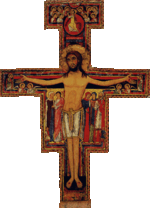
Hierarchy Pope · Cardinals · Patriarchs · Major Archbishops · Primates · Metropolitans · Archbishops · Diocesan BishopsTheology Sacraments Mariology Doctors of
the ChurchAlbertus Magnus · Ambrose · Anselm of Canterbury · Anthony of Padua · Thomas Aquinas · Athanasius of Alexandria · Augustine of Hippo · Basil of Caesarea · Bede · Robert Bellarmine · Bernard of Clairvaux · Bonaventure · Petrus Canisius · Catherine of Siena · Peter Chrysologus · John Chrysostom · Cyril of Alexandria · Cyril of Jerusalem · Peter Damian · Ephrem the Syrian · Francis de Sales · Gregory of Nazianzus · Gregory the Great · Hilary of Poitiers · Isidore of Seville · Jerome · John of Damascus · John of the Cross · Lawrence of Brindisi · Leo the Great · Alphonsus Maria de Liguori · Teresa of Ávila · Thérèse of LisieuxPope Benedict XVI Preceding Popes Orders and
SocietiesVatican II Particular Churches
sorted by
Liturgical TraditionsAlexandrian · Coptic · Ethiopic · Antiochian · Maronite · Syriac · Syro-Malankara · Armenian · Armenian · Byzantine · Albanian · Belarusian · Bulgarian · Croatian · Greek · Hungarian · Italo-Albanian · Macedonian · Melkite · Romanian · Russian · Ruthenian · Slovak · Ukrainian · East Syrian · Chaldean · Syro-Malabar · Latin · Roman · Anglican Use · Sarum · Ambrosian · MozarabicHistory of the Catholic Church General History of the Catholic Church · History of the Papacy · History of the Roman Curia · Catholic Ecumenical Councils · Timeline of the Catholic Church · History of Christianity · Role of the Catholic Church in Western civilization · Art in Roman Catholicism · Catholic religious order · Christian monasticism · Papal States
Church beginnings Constantine the Great to
Pope Gregory IConstantine the Great and Christianity · Arianism · Basilica of St. John Lateran · First Council of Nicaea · Pope Sylvester I · First Council of Constantinople · Biblical canon · Jerome · Vulgate · First Council of Ephesus · Council of Chalcedon · Benedict of Nursia · Second Council of Constantinople · Pope Gregory I · Gregorian chant
Early Middle Ages Third Council of Constantinople · Saint Boniface · Byzantine Iconoclasm · Second Council of Nicaea · Charlemagne · Pope Leo III · Fourth Council of Constantinople · East–West Schism
High Middle Ages Pope Urban II · Investiture Controversy · Crusades · First Council of the Lateran · Second Council of the Lateran · Third Council of the Lateran · Pope Innocent III · Latin Empire · Francis of Assisi · Fourth Council of the Lateran · Inquisition · First Council of Lyon · Second Council of Lyon · Bernard of Clairvaux · Thomas Aquinas
Late Middle Ages Protestant Reformation/
Counter-ReformationBaroque Period to the
French Revolution19th century Pope Pius VII · Pope Pius IX · Dogma of the Immaculate Conception of the Virgin Mary · Our Lady of La Salette · Our Lady of Lourdes · First Vatican Council · Papal infallibility · Pope Leo XIII · Mary of the Divine Heart · Prayer of Consecration to the Sacred Heart · Rerum Novarum
20th century Pope Pius X · Our Lady of Fátima · Persecutions of the Catholic Church and Pius XII · Pope Pius XII · Pope Pius XII Consecration to the Immaculate Heart of Mary · Dogma of the Assumption of the Virgin Mary · Pope John XXIII · Second Vatican Council · Pope Paul VI · Pope John Paul I · Pope John Paul II
21st century By country or region Brazil · Cuba · France · Germany · Hispano-America · Ireland · Japan · Mexico · Spain · United States · Venezuela
Categories:- 1st-century births
- 101 deaths
- Church Fathers
- Christian slaves and freedmen
- Popes
- Italian popes
- Christian martyrs of the Roman era
- Apostolic Fathers
- Papal saints
- 1st-century archbishops
- Saints of the Golden Legend
- 1st-century Romans
- Anglican saints
- People celebrated in the Lutheran liturgical calendar
- People executed by drowning
Wikimedia Foundation. 2010.

